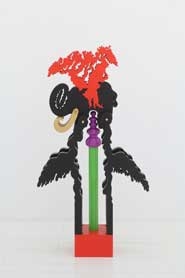Keiichi Tanaami has enjoyed a Zurich renaissance of late, thanks to exhibitions at Studiolo and now Karma International. The seventy-something Japanese artist and designer was never forgotten – he has exhibited steadily since the 1960s – but exhibitions like this one nonetheless fill in blanks in his remarkable back catalogue. On show at Karma are poster designs from the late 1960s, a 1969 collage, numerous Dream Diary Drawings (2007–12) and a large canvas triptych, Elephant and whale in cherry blossoms falling day (2013), while the gallery’s back office is crowded with other sculptures and works on paper.
If Tanaami was employing distortions redolent of hallucinations in that period, the recent painting on display is a much more psychedelic experience
Posters like No More War_4 (1967) make the first impression: intensely coloured silkscreened designs suggest the era of their making viewed through drug-addled eyes. The antiwar message of this work’s title is just a grace note between two burnt-red female faces that loom over an image of a wavy-lined sunset reflecting on water, while another woman holding an oversize flower is seen in front of a larger torso, the face above it an orange blank. If Tanaami was employing distortions redolent of hallucinations in that period, the recent painting on display is a much more psychedelic experience. Together the three panels of Elephant and whale… are three metres wide and two metres tall, and jam-packed with forms and details that pulse before your eyes. The subjects are nominally a breaching and blowing whale and a yellow elephant against a blue sky thick with pink blossoms, but the image is a tumult of other creatures. Fix on one form and you can no longer decipher its surroundings, pan out and the focus is lost. The water writhes with recurrent characters from Tanaami’s oeuvre: a lute with eyes forms the face of a hunched monklike figure walking with a stick; a snake has a man’s head; skulls abound, as do more long-lashed eyes; there are cockerels too. Even the surfaces within these forms are delivered with virtuoso touches. The elephant is filled with a dot pattern that references Lichtenstein while complicating, not clarifying, depth of field; the black and white spray on the water calls to mind classical Japanese landscapes; and the tigers at the base stretch out like Hans Holbein’s anamorphic skull in The Ambassadors (1533).
While Elephant and whale… is a tour de force, it is the Dream Diary Drawings that are most intriguing. On display are 80 pages, 38 × 50 cm each, some collaged but largely in coloured pencil, that find room for all kinds of fantasies – sexual, medical, biological and even architectural. Each is divided into two portrait-format drawings that sometimes mirror each other across the centrefold and often evolve from one side of the page to the next. In one, for example, the right-hand side shows a man pushing down on the shoulders of a woman upright in a pool; on the left-hand side the same scene is repeated, but her eyes are closed and something like a starfish, with an eye, is boring into her abdomen. Whether the man is ministering or abusing is unclear. Seen en masse (though still only a fraction of Tanaami’s diaries), this collection suggests the artist is observer, not agent, of these visions. But once captured, they are the stuff with which he cultivates a vocabulary and a cast to populate his extraordinary canvases.
This review originally appeared in the September 2013 issue.
